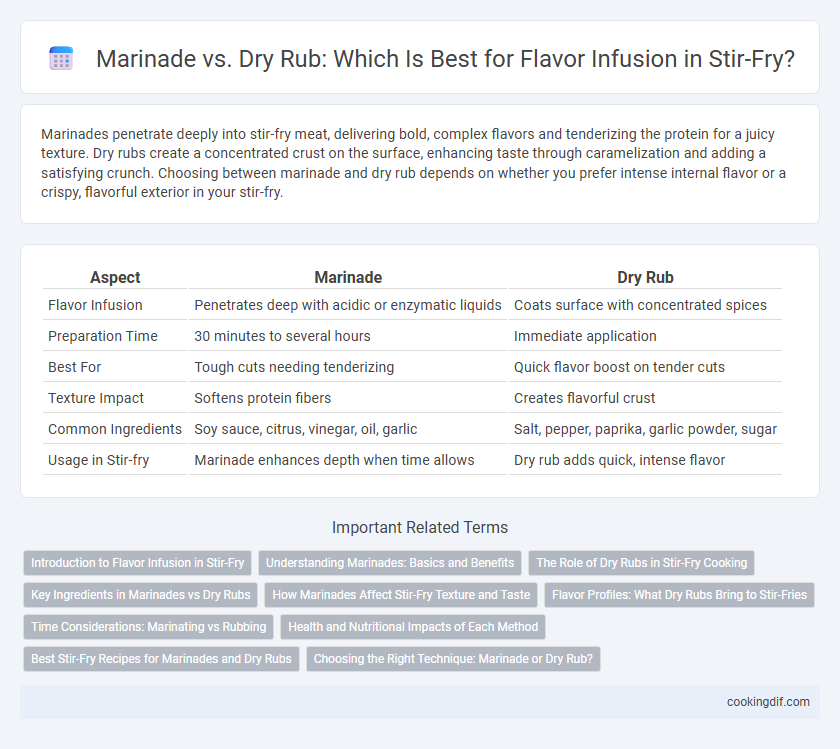Marinades penetrate deeply into stir-fry meat, delivering bold, complex flavors and tenderizing the protein for a juicy texture. Dry rubs create a concentrated crust on the surface, enhancing taste through caramelization and adding a satisfying crunch. Choosing between marinade and dry rub depends on whether you prefer intense internal flavor or a crispy, flavorful exterior in your stir-fry.
Table of Comparison
| Aspect | Marinade | Dry Rub |
|---|---|---|
| Flavor Infusion | Penetrates deep with acidic or enzymatic liquids | Coats surface with concentrated spices |
| Preparation Time | 30 minutes to several hours | Immediate application |
| Best For | Tough cuts needing tenderizing | Quick flavor boost on tender cuts |
| Texture Impact | Softens protein fibers | Creates flavorful crust |
| Common Ingredients | Soy sauce, citrus, vinegar, oil, garlic | Salt, pepper, paprika, garlic powder, sugar |
| Usage in Stir-fry | Marinade enhances depth when time allows | Dry rub adds quick, intense flavor |
Introduction to Flavor Infusion in Stir-Fry
Marinades penetrate stir-fry ingredients by soaking them in a flavorful liquid mixture of soy sauce, garlic, ginger, and sesame oil, enhancing moisture and depth of taste. Dry rubs use a blend of spices and herbs like five-spice powder, chili flakes, and ground pepper, coating the surface to deliver concentrated bursts of flavor. Choosing between marinade and dry rub depends on the desired intensity and texture of flavor infusion in quick-cooked stir-fry dishes.
Understanding Marinades: Basics and Benefits
Marinades infuse stir-fry ingredients with moisture and depth by combining acidic elements like vinegar or citrus with oils and spices, enhancing tenderness and flavor absorption. Unlike dry rubs, marinades penetrate the surface, breaking down proteins and allowing for a more evenly distributed taste profile. Using marinades in stir-fry prep results in vibrant, juicy bites that maintain texture while intensifying seasoning complexity.
The Role of Dry Rubs in Stir-Fry Cooking
Dry rubs play a crucial role in stir-fry cooking by creating a concentrated layer of spices that adhere directly to proteins or vegetables, enhancing the overall flavor intensity. Unlike marinades, dry rubs do not add moisture, preserving the food's texture and enabling quick, high-heat cooking essential for authentic stir-fry dishes. The application of dry rubs improves caramelization and promotes a flavorful crust, contributing to a more complex and aromatic stir-fry experience.
Key Ingredients in Marinades vs Dry Rubs
Marinades typically combine acidic liquids like vinegar or citrus juice, oils, and aromatic herbs or spices to penetrate and tenderize meat, enhancing flavor complexity and moisture retention. Dry rubs rely on a concentrated blend of ground spices, salt, sugar, and sometimes dried herbs to create a flavorful crust through direct contact with the protein's surface. Key ingredients in marinades emphasize moisture and flavor absorption, while dry rubs prioritize texture and a bold, intensified taste profile.
How Marinades Affect Stir-Fry Texture and Taste
Marinades infuse stir-fry ingredients with moisture and depth of flavor by breaking down proteins and enhancing tenderness, resulting in a juicier, more succulent texture. Acidic components like vinegar or citrus in marinades help to soften vegetables and meats, allowing flavors to penetrate evenly during cooking. Unlike dry rubs, marinades provide a balanced blend of seasoning and moisture, improving overall taste complexity and mouthfeel in each bite.
Flavor Profiles: What Dry Rubs Bring to Stir-Fries
Dry rubs bring intense, concentrated flavor profiles to stir-fries by coating proteins and vegetables with a blend of spices and herbs that create a robust, caramelized crust during cooking. Unlike marinades, which infuse moisture and tenderize, dry rubs emphasize a dry, bold seasoning that enhances the Maillard reaction, resulting in deep, complex umami and smoky notes. Key ingredients like paprika, garlic powder, cumin, and chili flakes in dry rubs amplify the savory and spicy dimensions, making each bite richly flavored without diluting texture.
Time Considerations: Marinating vs Rubbing
Marinating meat or vegetables requires a minimum of 30 minutes to several hours, allowing flavors and moisture to penetrate deeply for enhanced tenderness and taste. Dry rubs can be applied shortly before cooking, offering a quicker method to infuse spices and create a flavorful crust without the need for extended preparation. Choosing between marinating and dry rubbing depends on the desired depth of flavor and available preparation time for the stir-fry dish.
Health and Nutritional Impacts of Each Method
Marinades enhance stir-fry dishes by infusing moisture and nutrients from ingredients like citrus, herbs, and oils, which can increase antioxidant intake and improve digestion. Dry rubs concentrate spices and herbs directly on the food's surface, offering a lower-sodium option while delivering potent flavors and potential anti-inflammatory benefits. Choosing between marinade and dry rub affects calorie content and nutrient absorption, with marinades often providing more vitamins from fresh ingredients and dry rubs reducing added sugars and fats.
Best Stir-Fry Recipes for Marinades and Dry Rubs
Marinades penetrate proteins deeply in stir-fry dishes, infusing flavors through a blend of soy sauce, garlic, ginger, and sesame oil that enhances moisture and tenderness. Dry rubs, composed of ground spices like five-spice powder, chili flakes, and turmeric, create a bold, concentrated crust on meats or tofu, locking in flavor during high-heat cooking. The best stir-fry recipes balance marinade soaking times and dry rub application to maximize aroma and taste while preserving texture.
Choosing the Right Technique: Marinade or Dry Rub?
Choosing between a marinade and a dry rub depends on the desired flavor intensity and texture for stir-fry dishes. Marinades, typically acidic and liquid-based with ingredients like soy sauce, garlic, and ginger, penetrate proteins deeply, enhancing tenderness and imparting a rich, balanced taste. Dry rubs, composed of concentrated spices and herbs such as chili powder, cumin, and black pepper, create a flavorful crust that intensifies surface taste without altering the meat's moisture content.
Marinade vs dry rub for flavor infusion Infographic

 cookingdif.com
cookingdif.com